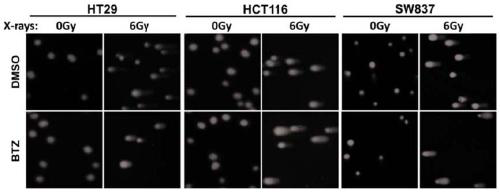Composition for cancer radiotherapy sensitization and application thereof
A composition and cancer technology, applied in the field of tumor, can solve the problems of no research results and insufficient excavation, and achieve the effect of effective treatment strategy, major clinical and socio-economic significance
- Summary
- Abstract
- Description
- Claims
- Application Information
AI Technical Summary
Problems solved by technology
Method used
Image
Examples
Embodiment 1
[0038] Example 1 Tumor Synergistic Inhibition Experiment
[0039] Four kinds of cells including HT-29, HCT116, SW837 and FaDu were selected, and bortezomib (BTZ), elsazomib (IXZ) and carfilzomib (CFZ) were selected as proteasome inhibitors (PIs) for the experiment. The effect of radiotherapy on cell proliferation is mainly reflected by the clone formation ability of cells. The specific experimental methods are as follows:
[0040]HCT116, HT29, SW837 and FaDu cells were seeded into 6-well plates at a density of 1000 cells / well. After 24 hours, cells were treated with indicated doses of X-rays or drugs, then cultured for 10–14 days, fixed with methanol, and stained with 0.5% crystal violet. Colonies containing more than 50 cells were counted.
[0041] The results showed that low concentrations of BTZ, IXZ, and CFZ could significantly weaken the colony formation ability of HT29, HCT116, SW837, and FaDu cells after radiotherapy (such as figure 1 As shown), and with the increase...
Embodiment 2
[0048] Example 2 DNA double-strand breaks (DSBs) damage and cell apoptosis experiment
[0049] The most direct effect of radiotherapy is to cause DNA double-strand breaks. Based on the above obvious synergistic effects, the degree of DNA damage is further judged by the comet experiment. In this experiment, three cell lines, HT-29, HCT116 and SW837, were selected, and bortezomib (BTZ) was selected as proteasome inhibitors (PIs). The specific experimental method is as follows:
[0050] The cells were first treated with PIs for 12 hours, then irradiated with X-rays (6Gy), cultured for 6 hours, and then collected with a comet assay kit (4250-050-K, Trevigen, Gaithersburg, MD, USA) and cultured at 3× 10 5 Cells / mL were resuspended in PBS for DNA damage analysis. Comet experiments were then performed according to the manufacturer's instructions. After PI staining, comet images were taken with a fluorescence microscope. The average comet tail moment (percentage of DNA in the tai...
Embodiment 3
[0056] Example 3 In vivo tumor suppression experiment
[0057] HCT116 cells were transplanted into tumor blocks (approximately 5mm 3 ) were implanted subcutaneously on the right side of nude mice to establish xenograft models, and were randomly divided into 4 groups: BTZ-radiotherapy X-ray combined treatment group, normal saline (NS)-radiotherapy X-ray combined group, BTZ group, and normal saline (NS) group . The BTZ-X-ray combined therapy group and the normal saline (NS)-radiotherapy X-ray combined group were given BTZ (0.1 mg / kg / day × 7 days) and X-ray radiation every other day in turn from the 7th day after the tumor was planted. Treatment, BTZ group and normal saline (NS) group were administered in the same manner as the first two groups, but no radiation therapy was performed, the tumor volume was measured once a week, and the treatment cycle was 14 days. After 3 weeks of treatment, the mice were sacrificed to remove the tumor mass ( Tumors such as Figure 6 shown).
...
PUM
 Login to View More
Login to View More Abstract
Description
Claims
Application Information
 Login to View More
Login to View More - R&D
- Intellectual Property
- Life Sciences
- Materials
- Tech Scout
- Unparalleled Data Quality
- Higher Quality Content
- 60% Fewer Hallucinations
Browse by: Latest US Patents, China's latest patents, Technical Efficacy Thesaurus, Application Domain, Technology Topic, Popular Technical Reports.
© 2025 PatSnap. All rights reserved.Legal|Privacy policy|Modern Slavery Act Transparency Statement|Sitemap|About US| Contact US: help@patsnap.com



